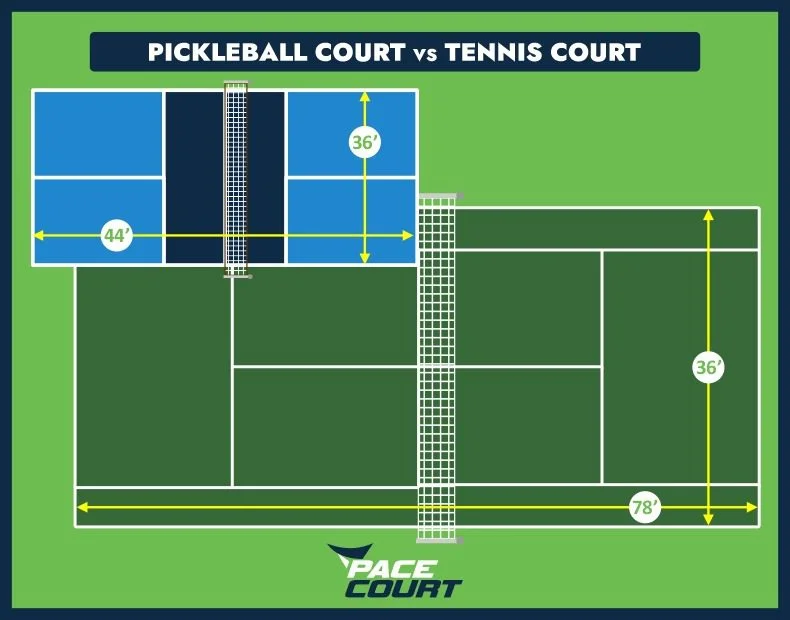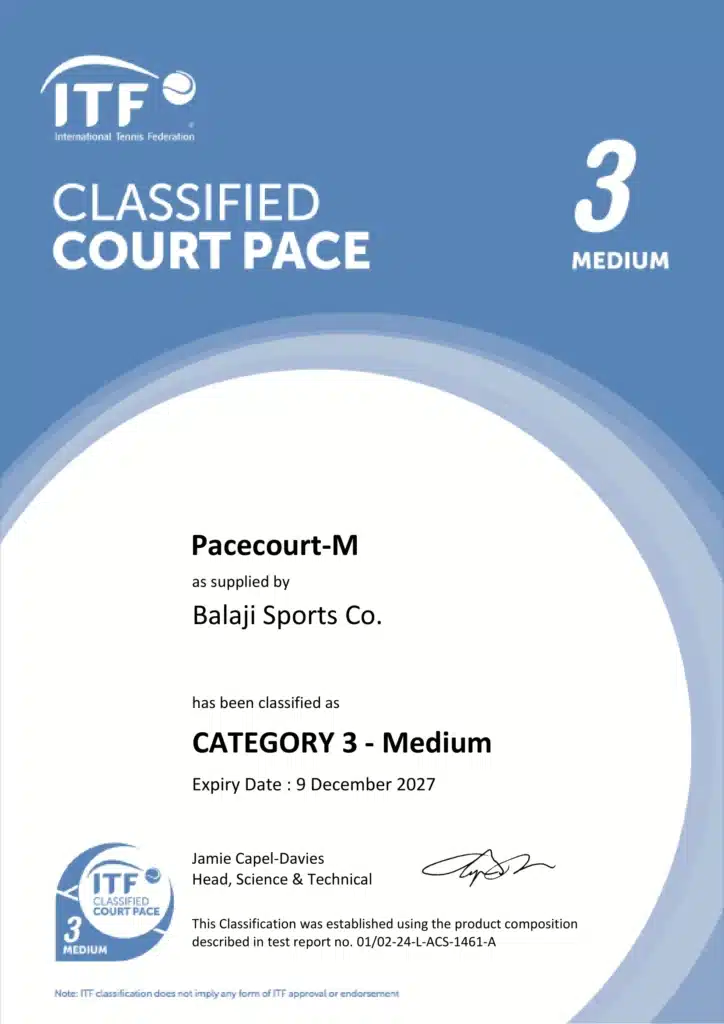
As sports trends evolve, the demand for multi-use play areas is growing. One sport leading the charge is pickleball—a fun, fast-paced, and inclusive game for all ages. With its rapid rise in popularity, many communities, clubs, and schools are now looking to convert tennis court to pickleball court to make the most of the space and meet growing demand.
Why the change? Simply put, pickleball is played on a much smaller court so that multiple games can be played at once on a single tennis court. It’s a cost-effective and efficient use of existing infrastructure.
In this guide, Pacecourt—your go-to source for high-quality synthetic acrylic flooring materials—breaks down the differences between tennis and pickleball courts, the benefits of conversion, and walks you through the entire process of converting.
Key Differences Between Tennis and Pickleball Courts
Before you start converting, you need to understand the structural differences. Knowing how pickleball courts differ from tennis courts will ensure accuracy and playability during conversion.
- Dimensions: A tennis court is 78 feet long by 36 feet wide; a pickleball court is 44 feet by 20 feet. You can fit multiple pickleball courts in one tennis court—maximize your usage.
- Line Markings: Tennis courts have larger service boxes, baselines, and sidelines. Pickleball courts have a 7-foot non-volley zone (kitchen) on either side of the net, which is a key part of the game.
- Net Height: The Tennis net is 36 inches at the center, and the pickleball net is 34 inches. It affects the ball trajectory and play style.
- Surface Material: Both sports can be played on the same surface. Pacecourt’s high-quality synthetic acrylic flooring is great for pickleball court surfaces and tennis court surface.
Benefits of Converting a Tennis Court to a Pickleball Court
Converting a tennis court into a pickleball court has many practical and community benefits. It’s not just space-saving—it’s an investment in the future of recreational sport.
- Space-efficient reuse: One of the biggest benefits is that you can reuse underutilized tennis courts instead of building from scratch. It saves construction costs and time, making it an affordable option for sports clubs and communities.
- Meets the growing demand for pickleball: With pickleball growing in popularity, more people of all ages are encouraged to play with the provision of dedicated courts. Municipalities and sports centers provide facilities to accommodate the increasing needs of players and spectators.
- Multi-purpose: One tennis court can convert to 1 to 4 pickleball courts per tennis court, depending on the configuration. It allows for flexible programming—informal games, tournaments, and teaching clinics.
- Community involvement and accessibility: The simplicity of the rules and slower pace of pickleball allow more people, especially seniors and beginners, to participate. These factors make community involvement stronger and promote healthy living.

Conversion Options
When you convert a tennis court to a pickleball court, you can go with temporary or permanent (or semi-permanent) solutions depending on your budget, how often you’ll use it, and what you envision for the long term.
A. Temporary Conversion
Perfect for recreational play, community gatherings, or sampling interest in pickleball prior to investing in a complete conversion. Temporary conversions are fast, inexpensive, and completely reversible. You can:
Use collapsible pickleball nets that can be quickly put away and pulled out. Use temporary court markings with tape or chalk that can be eliminated or moved when desired. Return to a complete tennis court configuration whenever you desire.
B. Permanent or Semi-Permanent Conversion
For neighborhoods that are fully committed to pickleball, a more fixed arrangement is sensible. This entails:
- Resurface the court with fixed pickleball markings and good-quality paint.
- Install permanent pickleball nets for durability and convenience.
Because most conversions occupy around 50% of the tennis court, there is still some space available for multi-use set-ups or combining tennis and pickleball courts into shared playing surfaces.
4. How to Convert: Step-by-Step
Converting a tennis court flooring to a pickleball court flooring requires planning and precision. Here’s a step-by-step guide to help you do it smoothly.
1. Existing Tennis Court Inspection: Start by assessing the surface, orientation, and space on the court. An ideal surface should be smooth and crack-free. Decide if a full conversion or mixed-use installation is best for your community.
2. Type of Conversion: Choose between a single-purpose pickleball court or a blended court with two uses that keeps tennis lines. Blended courts are flexible; single-purpose courts are more defined playing experiences.
3. Court Line Marking
Learn how to outline and position your pickleball court properly:
- 20’ x 44’ overall space
- 7’ non-volley zone (kitchen) on either side of the net
- Accurate baselines, sidelines, and centerlines
4. Net Setup: You can lower the existing tennis net to 34” in the middle or put up a pickleball net for official play.
5. Optional Resurfacing: Add some flair to the court with acrylic finishes, anti-skid coatings, and special color treatment using Pacecourt’s high-grade acrylic sports flooring for better grip, safety, and durability.
Gameplay Rules and Scoring
Both pickleball and tennis have rackets, nets, and court play, but the rules and scoring systems are quite different, and that changes strategy and pace. In pickleball, games are played to 11 and you must win by 2. Importantly, only the serving side can score so every serve is a big deal. Serves must be underhand and diagonal and clear the net and land beyond the 7-foot non-volley zone (kitchen). This zone prevents players from volleying too close to the net, adding a new tactical layer.
Tennis has a more complex scoring system of points, games, sets, and matches. Players can score on both serve and return. Serves are overhand, and there’s no non-volley zone, so players can play more aggressively at the net. These differences make pickleball more accessible and faster paced, especially for beginners and older players, and tennis demands more endurance and technique.
Number of Pickleball Courts on One Tennis Court
One of the biggest benefits of converting tennis courts into pickleball courts is space efficiency. Because pickleball is played on a much smaller court, you can use existing facilities without needing more land.
- One tennis court can be converted into four pickleball courts, perfect for community centers, clubs, and tournaments. The standard way is to put two pickleball courts on each side of the tennis net, perpendicular to the original tennis court layout. It works well and keeps visibility and flow of play.
- To ensure safety and comfort, leave at least 5 feet of space between courts. This buffer allows players to move freely without risk of collision or interference.
- Four standard pickleball courts on a tennis court are an efficient and cost-effective way to get more people playing and support the growing pickleball community.
Materials and Surface Recommendations
For safe and durable play on your converted pickleball courts, you need to choose the right materials and surface treatments. The court surface affects player performance, comfort, and injury prevention.
- Acrylic flooring is the number one choice for outdoor pickleball and tennis courts because it’s weatherproof, non-slip, and long-lasting. It can withstand harsh sun, rain, and temperature changes and maintain consistent play all year round.
- For extra player comfort and safety, especially for seniors or those with joint issues, cushioned coatings provide excellent shock absorption. These layers reduce impact stress and make the court more forgiving during quick movements and sudden stops.
- And don’t forget the line markings. High-visibility, fade-resistant line paints ensure clear boundaries for both players and officials and keep the court looking professional and functional for years to come.
At Pacecourt, we specialize in premium acrylic sports flooring and offer a wide range of pickleball court flooring and tennis court flooring materials. Whether you’re converting a full or partial court, Pacecourt’s products deliver quality, durability, and playability for every level of sport.
Maintenance Tips Post-Conversion
Now that your tennis court has been converted to a pickleball court and is up and running, it’s important to keep it maintained so it remains safe, looks good, and plays well for years to come. One of the easiest and most important is regular surface cleaning. Removing dirt, leaves, and debris prevents the surface from deteriorating and maintains traction, reducing the risk of slips and falls.
Repainting the court lines every year keeps the borders sharp and visible, especially important for pickleball’s smaller courts and strategic areas like the non-volley kitchen. Clear lines also look professional and improve play.
Net maintenance is also key. Check the nets regularly for wear, tear, or sagging. Adjust the tension to keep the net at 34 inches at the center for consistent play.
Finally, look for cracks on the surface, bubbles, or peeling. Fix these early with resurfacing or repairs to avoid more costly damage down the road and extend the life of your court.
By following these maintenance tips, you’ll protect your investment and have a great playing experience.
Best Sports Flooring for All Sports: Smooth Performance & Strong Grip
| Multi-Purpose Court Flooring | Badminton Court Flooring | Volleyball Court Flooring |
| Basketball Court Flooring | Walking Track Flooring | Cycle Track Flooring |
Conclusion
Whether you’re a homeowner, sports club, or municipality, converting tennis courts into pickleball courts is a smart move. It is in line with modern sports trends, utilizes the space you have, and increases community engagement by providing fun recreation for all ages and skill levels. With pickleball’s growing popularity, it’s essential to adapt facilities to meet player demand without the cost of new builds. A converted court gets maximum usage and encourages healthy lifestyles and social interaction.
Looking to start your court conversion? Contact Pacecourt for expert advice and top-quality tennis court flooring and pickleball court surfaces. Our products and advice will give you a court that performs, is safe, and is enjoyable for everyone. Trust Pacecourt to create a versatile, durable, and inviting sports space.
Frequently Asked Questions
One tennis court can fit up to 4 pickleball courts, laid out perpendicular to each other with safe spacing in between for play and community use.
Pickleball has a smaller court, lower net, underhand serves and a non-volley zone; tennis has a larger court, higher net and overhand serves with traditional scoring.
Yes, with a little tweaking (adjusting the net height and new line markings), a tennis court can be used for one or multiple pickleball courts.
No, pickleball courts are smaller, have different line layouts and have lower nets. But both can share the same surface when converted properly using blended or dedicated designs.
Acrylic with anti-skid and cushioned layers is ideal. It’s durable, weather resistant and has safe traction for both recreational and competitive play.



